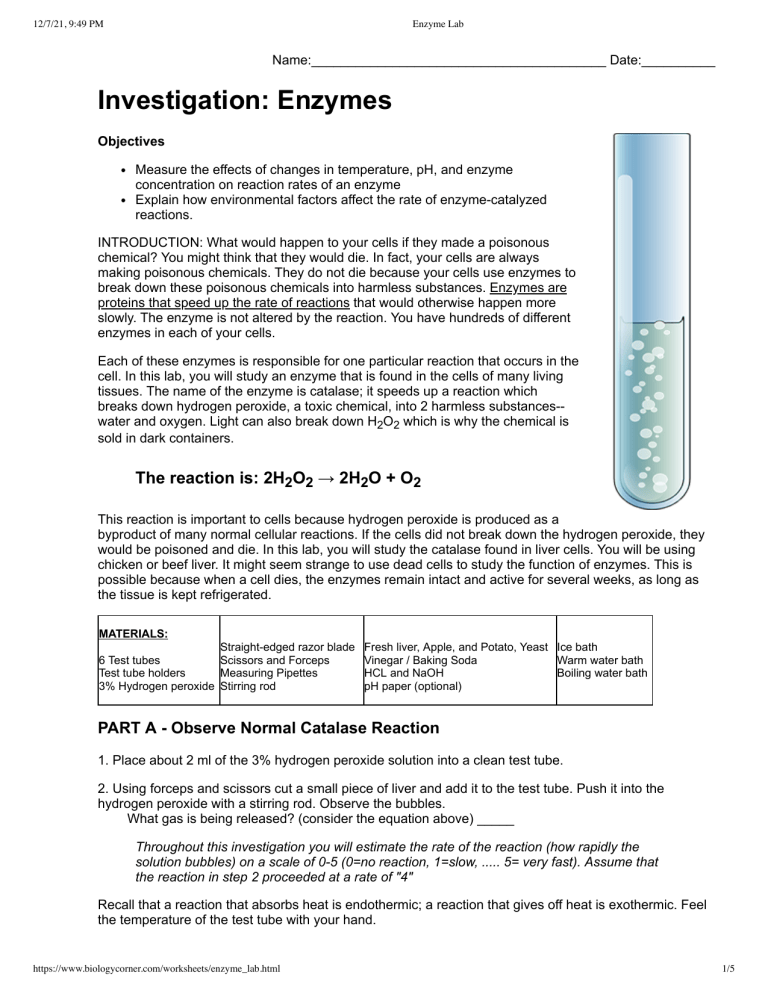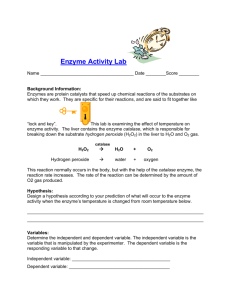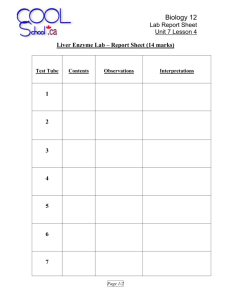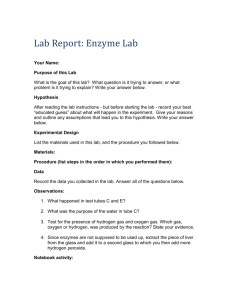
12/7/21, 9:49 PM Enzyme Lab Name:________________________________________ Date:__________ Investigation: Enzymes Objectives Measure the effects of changes in temperature, pH, and enzyme concentration on reaction rates of an enzyme Explain how environmental factors affect the rate of enzyme-catalyzed reactions. INTRODUCTION: What would happen to your cells if they made a poisonous chemical? You might think that they would die. In fact, your cells are always making poisonous chemicals. They do not die because your cells use enzymes to break down these poisonous chemicals into harmless substances. Enzymes are proteins that speed up the rate of reactions that would otherwise happen more slowly. The enzyme is not altered by the reaction. You have hundreds of different enzymes in each of your cells. Each of these enzymes is responsible for one particular reaction that occurs in the cell. In this lab, you will study an enzyme that is found in the cells of many living tissues. The name of the enzyme is catalase; it speeds up a reaction which breaks down hydrogen peroxide, a toxic chemical, into 2 harmless substances-water and oxygen. Light can also break down H2O2 which is why the chemical is sold in dark containers. The reaction is: 2H2O2 → 2H2O + O2 This reaction is important to cells because hydrogen peroxide is produced as a byproduct of many normal cellular reactions. If the cells did not break down the hydrogen peroxide, they would be poisoned and die. In this lab, you will study the catalase found in liver cells. You will be using chicken or beef liver. It might seem strange to use dead cells to study the function of enzymes. This is possible because when a cell dies, the enzymes remain intact and active for several weeks, as long as the tissue is kept refrigerated. MATERIALS: Straight-edged razor blade 6 Test tubes Scissors and Forceps Test tube holders Measuring Pipettes 3% Hydrogen peroxide Stirring rod Fresh liver, Apple, and Potato, Yeast Ice bath Vinegar / Baking Soda Warm water bath HCL and NaOH Boiling water bath pH paper (optional) PART A - Observe Normal Catalase Reaction 1. Place about 2 ml of the 3% hydrogen peroxide solution into a clean test tube. 2. Using forceps and scissors cut a small piece of liver and add it to the test tube. Push it into the hydrogen peroxide with a stirring rod. Observe the bubbles. What gas is being released? (consider the equation above) _____ Throughout this investigation you will estimate the rate of the reaction (how rapidly the solution bubbles) on a scale of 0-5 (0=no reaction, 1=slow, ..... 5= very fast). Assume that the reaction in step 2 proceeded at a rate of "4" Recall that a reaction that absorbs heat is endothermic; a reaction that gives off heat is exothermic. Feel the temperature of the test tube with your hand. https://www.biologycorner.com/worksheets/enzyme_lab.html 1/5 12/7/21, 9:49 PM Enzyme Lab Has it gotten warmer or colder? _____________________ Is the reaction endothermic or exothermic? _____________________ 3. Pour off the liquid into a second test tube. Assuming the reaction is complete, what is this liquid composed of? __________________ What do you think would happen if you added more liver to this liquid? ______________________ Test this and record the reaction rate. Reaction Rate ___________ (1 – 5) 4. Add another 2ml of hydrogen peroxide to the liver remaining in the first test tube. What is the reaction rate? ____ Synthesis -- Answer the question: Is catalase reusable? CLAIM: EVIDENCE REASONING. Part B - What Tissues Contain Catalase? You will now test for the presence of catalase in tissues other than liver. Place 2 ml of hydrogen peroxide in each of 3 clean test tubes and then add each of the three test substances to the tubes. As you add each test substance, record the reaction rate (0-5) for each tube. Substance Apple Potato Yeast Rate of Reaction (0-5) Synthesis -- Do all living tissues contain catalase? Claim: Evidence: Reasoning: https://www.biologycorner.com/worksheets/enzyme_lab.html 2/5 12/7/21, 9:49 PM Enzyme Lab PART C - What is the Effect of Temperature on Catalase Activity? 1. Put a piece of liver into the bottom of a clean test tube and cover it with a small amount of water. Place this test tube in a boiling water bath for 5 minutes. 2. Remove the test tube from the hot water bath, allow it to air cool, then pour out the water. Add 2 ml of hydrogen peroxide. CAUTION: Use a test-tube holder for hot test tubes. What is the reaction rate for the boiled liver and peroxide? __________ 3. Put equal quantities of liver into 2 clean test tubes and 1 ml H2O2 into 2 other test tubes. Put one test tube of liver and one of H2O2 into an ice bath. Place the other set in a warm water bath (not boiling). After 3 minutes, pour each tube of H2O2 into the corresponding tube of liver and observe the reaction What is the reaction rate for the cold liver/peroxide? _____ What is the reaction rate for the warm liver/peroxide? ____ Synthesis -- How does temperature affect the catalase enzyme? Claim: Evidence: Reasoning: PART D - What is the Effect of pH on Catalase Activity 1. Add 2 ml hydrogen peroxide to 4 clean test tubes, then add: Tube 1 – add 3 drops of acetic acid (vinegar) pH =_______ Tube 2 – add 3 drops of sodium bicarbonate (base) pH =______ Tube 3 – add 3 drops of water (neutral) pH =_____ Tube 4 -- add 3 drops of 1M NaOH pH = _____ Now add liver to each of the test tubes (try to do it all at about the same time, so you can easily compare) Rate of Reaction for: Strong Acid (HCL) ____ Acid _____ https://www.biologycorner.com/worksheets/enzyme_lab.html Neutral ______ Base_____ Strong base (NAOH) _____ 3/5 12/7/21, 9:49 PM Enzyme Lab 1. How does pH affect the reaction rate of catalase? Propose a way to refine your experiment to find the exact, or OPTIMAL pH and temperature of catalase. 2. The following graph shows reaction rates of various enzymes in the body. Pepsin is found in the stomach, amylase in the saliva, and phosphatase in the liver. Synthesis: How does pH affect the activity of enzymes? Claim: Evidence: Reasoning: Part E - Design an Experiment Lactaid is a product designed to help people who cannot digest milk sugar (lactose) because they are missing the enzyme lactase. Many people are lactose-intolerant, a condition that is mainly genetic. Lactase breaks down lactose into two subunits: glucose and galactose. To test for the presence of monosaccharides and reducing disaccharide sugars in food, the food sample is dissolved in water, and a small amount of Benedict's reagent is added. The solution should progress in the colors of blue (with no glucose present), green, yellow, orange, red, and then brick red when there is a large amount of glucose present. (Google benedict's test to see the way this looks.) Design an experiment where you would determine how quicly lactaid works to break down milk sugar at different temperatures.. Be specific in your description, use drawings if necessary. https://www.biologycorner.com/worksheets/enzyme_lab.html 4/5 12/7/21, 9:49 PM https://www.biologycorner.com/worksheets/enzyme_lab.html Enzyme Lab 5/5








